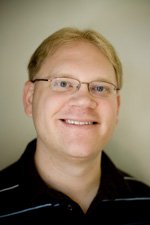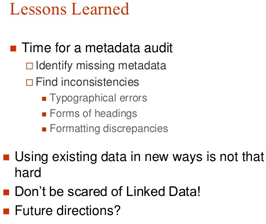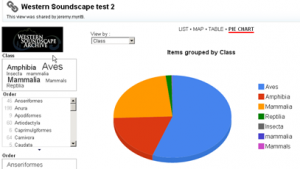This is a guest post from Camille Salas, an intern with the Library of Congress.
Jeremy Myntti is the Head of Cataloging and Metadata Services at the University of Utah’s J. Willard Marriott Library. Jeremy recently gave a presentation at the ALA Midwinter conference entitled Re-Discovering and Linking Metadata in Viewshare. In the presentation, he described how he created a view from the metadata of the Western Soundscape Archive. He found that Viewshare enabled “more possibilities for creating unique experiences for users.”
CS: Jeremy, please tell us about the Western Soundscape Archive and why Viewshare is a good platform for sharing it?
JM: The Western Soundscape Archive is a unique digital collection that features audio recordings of animals and their environments in the western United States. There are currently over 2,600 items in this collection, including sounds from birds, frogs and toads, reptiles, and mammals, as well as recordings of their environments. When the user interface for this collection was developed, some unique displays were created to help users find the items that they were interested in. Some of the features of our existing interface include some basic hierarchical browsing as well as a couple of different maps to display where the sounds were recorded or habitat maps for different species in five western states.
Viewshare is a good platform for displaying some of the data from this collection since it offers several additional types of views to help our users experience the collection. This includes pie charts, additional map interfaces, tag clouds and lists, timelines, and photo galleries.
CS: Please walk us through how you used Viewshare to visualize your Western Soundscape metadata.
JM: In my presentation, there are several slides with screenshots showing the step-by-step process that I used to generate views for theWestern Soundscape in Viewshare. The basic process was to export the metadata from CONTENTdm and then do some basic clean-up in Excel (e.g. removing unneeded fields and items). Since I had saved the metadata as a tab-delimited text file, it was very easy to load the data into Viewshare and begin playing around with it. I knew that I wanted to create a map view of the collection, so I used the “Add” a new field and “Augment” features within Viewshare to create the new field that would have the latitude and longitude information for the map. There were several attempts that I made at this, and I found that Viewshare was able to best augment the data and add latitude/longitude based off of a place name that was a common geographic name. Since the original metadata for this collection already had some latitude and longitude data, I needed to merge the new data that Viewshare created with the existing data. This process was done by exporting the data from Viewshare as a tab-delimited text file, merging the fields in Excel, and then re-loading the data back into Viewshare. That step was the most time consuming step in the whole process, but it still only took a few minutes.
Now that the data was in Viewshare the way that I wanted it, I was able to start creating some “views” or user interfaces. I was able to use the latitude and longitude data that was in the existing metadata as well as the new data added by Viewshare to create a map pinpointing the location that each sound was recorded. I also created some pie charts for a few fields of metadata, such as the common name, order, and class of each animal. Within the views, I created some lists and tag clouds as widgets in the sidebar to be used for some simple faceting. The entire process to load the data and create the different views took about one hour.
CS: Your process reminds me of a recent interview I conducted with Meghan Frazer concerning how she “amplified” collections with Viewshare and other tools. Meghan discovered that “wanting to use one tool to do everything is not realistic,” did you come to a similar conclusion? It’s interesting to hear similar approaches to building collections in Viewshare.
JM: Yes, I agree that doing everything with only one tool isn’t very realistic. In the current user interface that has been developed for theWestern Soundscape, there are multiple tools being used to generate the pages for users to discover the collection. Now with the knowledge of Viewshare, there are more possibilities open to us for creating unique experiences for our users.
CS: One of your final slides describes the lessons you learned about using Viewshare and perhaps visualizing information in general. Share a few of these lessons and what Viewshare users might glean from them.
JM: After completing this project with Viewshare, there are a couple of major things that I took away. First off is that it is never too late to audit your metadata in order to see what you actually have. By loading and then playing around with a few of the views in Viewshare, I was able to see some of our metadata that is missing or that needs to be cleaned-up because there were a number of inconsistencies such as the capitalization or spelling of different terms. I have also learned that it is not hard to use existing data in new ways.
Playing around with tools like Viewshare can then give you new ideas on ways to present your data which could help our users more readily discover our collections. Using Viewshare was also very easy and user friendly. If simple tools like Viewshare can help us move more towards a linked data environment, then we don’t need to be afraid of what might be coming in the future.
CS: In an Association for Library Collections & Technical Services Metadata blog post, you mention that Viewshare is helpful for thinking about new ways to present data and “help users more readily discover collections.” What kinds of users did you have in mind in creating your view? Did your eventual view prompt you to think about new groups of users? It seems like your view might be really helpful for science educators or those of us who could use a science refresher!
JM: There are many different types of users for the Western Soundscape Archive. With creating the map interfaces, we are helping users find information about animals that are within their region. The pie charts can help users as well as those working on the collection identify strengths and weaknesses of the collection in order to add more content for those areas that are lacking. These types of views can also be helpful to scientific researchers in identifying specific sounds and by being able to search for a particular biological classification. And like you say, this collection is also used by science educators to help reinforce the biological information of an animal by linking it to a sound and photograph.
CS: What were some of the most intriguing questions and comments by conference participants at the Midwinter session?
JM: A common comment that I received was that Viewshare looks like an interesting tool to expose your data, including any errors or inconsistencies that may reside in the data. Several people mentioned to me that they are interested in using some of their own data in Viewshare so that they can find new ways to display their data, as well as to find projects that they may need to work on or clean up. I also had a comment on how easy and user friendly Viewshare appeared to be, so even people without any programming or interface design experience can easily create their own unique views.
CS: Given your experience with Viewshare, are there any other features you would like to see that would enhance views for people with similar metadata?
JM: A major feature that I would love to see added to Viewshare would be the ability to browse through a collection hierarchically. Several fields of metadata that we have for theWestern Soundscape would benefit from this so that users could browse through the biological classification data (kingdom, phylum, class, order, family, genus).
I would also like to see a feature added to edit the metadata within Viewshare without having to export the data, edit in another tool like Excel or Google Refine, and then re-import the data into Viewshare. Along with this, it would be nice to be able to link the data in Viewshare to the data that we have stored in CONTENTdm so that the Viewshare data would be automatically updated whenever we updated our CONTENTdm metadata.
CS: Thanks, Jeremy, for your time and great suggestions!




